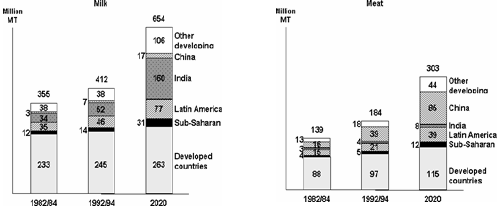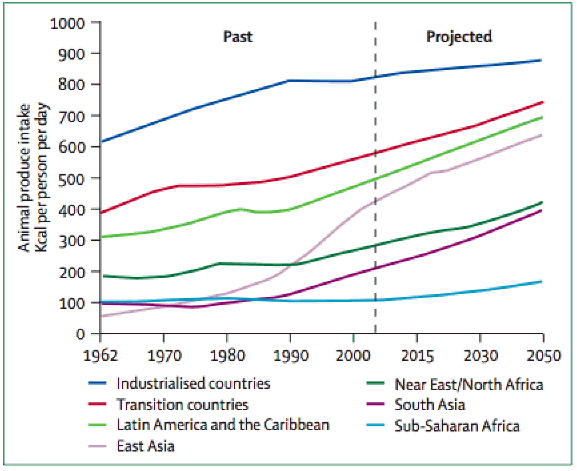People in developing countries consume more meat and milk, but still on averageonly 35% of the meat and milk respectively per capita compared to the developed countries (FAO, 2009). While the consumption of meat and milk per kg per capita from 1990 to 2003 has been almost the same in the developed countries of the world, it has during the same period of time changed with an increase of 21% for milk and 36% for meat in the developing world (FAO, 2009). Poor people everywhere are eating more animal products as theirincomes rise above poverty level and as they become urbanized.
By 2020, the share of developing countries in total world meatconsumption is projected to expand from 52% currently to 63% (Delgado, 2003). By 2020,developing countries will consume 107 million tons more meat and 177 million tons more milk than they did in 1996/1998, with highest increases in Asia, specifically East Asia for meat and South Asia for milk. Developed countries, however, will have much smaller increases of 19 million tons for meat and32 million tons for milk. The projected increase in livestock productionwill require annual feed consumption of cereals to rise by nearly300 million tons by 2020. In the long run Figure 8 shows the positive projection for Asia, whereas a continued increase in the gap between sub-Saharan Africa and the industrialized world is noted.

Figure 7. Total milk and meat consumption during 1983 and 1992 and projection for 2020.
Source: Delgado et al. (1999).

Figure 8. Trends in consumption of livestock products per person in different regions. Source: McMichael et al. (2007).
The demands for increased animal products are higher than for cereals because of changing consumption patterns following urbanization, population growth and projected income growth. Diets with more high-value protein and micronutrients will improve human health and the livelihoods of many poor people. The implications of the demands for increased food production and changed diets of billions of people may be dramatic in the next few decades and could improve the well-being of many rural poor, as both consumers and producers.
In contrast to the familiar Green Revolution, which started in plant production 30 years ago, a livestock revolution is just underway to meet the increase in demand for food of animal origin. Such a revolution assumes a wise use of natural resources, including animal and plant genetic resources, in order to be realized. The challenge is how to take advantage of prevailing trends for the benefit of the rural and sub-urban poor livestock keepers in developing countries rather than the more industrialized production in other parts of the world. Already predictions are that, unless major improvement in productivity occurs, East Asia and Africa will increasingly remain net importers of meat and milk products (FAO, 2005a). More than 70% of the predicted increase in the world’s meat consumption will be in form of pork and poultry, most of which will be produced under intensive industrial production, partly explaining the predicted trends in inter-regional cereal trade.
The higher pace of industrialization will continue, especially for pig and poultry production, but also for dairy production. This process may drive the small producers out of the ever-increasing competitive global market, for both economic and biological reasons. The benefits derived from economies of scale, leading to better resilience against disasters and calamities such as the recent bird flu and swine flu outbreaks, favourable domestic trade support and policy environments may further favour industrialized livestock production systems in the future.
Although mixed crop-livestock production systems will persist in the foreseeable future, higher levels of intensification will be required, with increased use of livestock genotypes that are likely to respond better to the changes in production systems.
ILRI, in its strategy to 2010 (ILRI, 2003), has identified activities in livestock research and development (R&D) for developing countries, which focus on poverty reduction, food and nutritional security, and environment and human health. It includes a substantial programme on characterization of indigenous AnGR and development of strategies for sustainable utilization of the diversity in livestock species, which assumes increased productivity, to improve the livelihoods of people in developing countries. Equally important, innovative ways must be sought to secure market access for the livestock products of developing countries. If this is not achieved, the globalization in trade of agricultural products is going to wipe out less competitive production systems in favour of products from industrialized ones in other parts of the world. See [ILRI Strategy to 2010].
